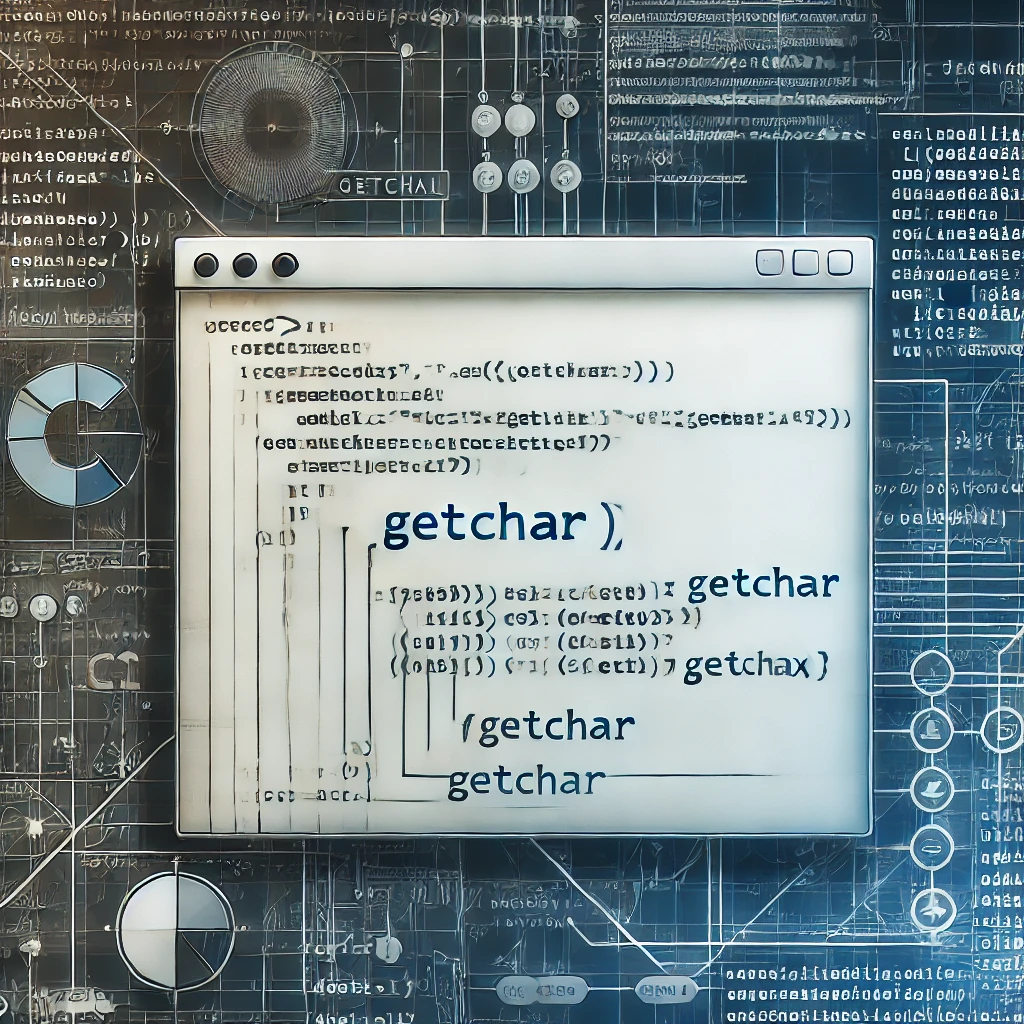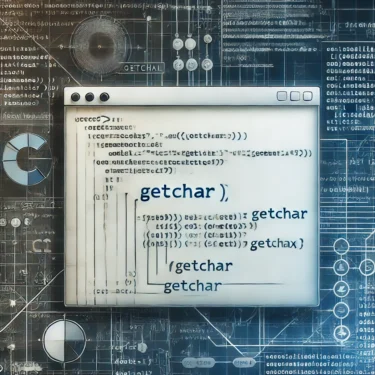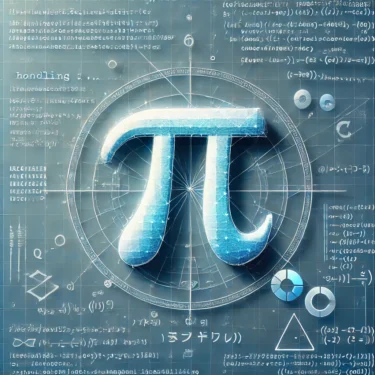1. What is the getchar Function?
The getchar function is one of the basic input functions in C, used to read a single character from standard input. This function waits for the user to enter a character via the keyboard, then returns the ASCII code of that character. It is useful for simple input operations, such as processing user input one character at a time.
Features of getchar
- Reads one character from standard input: It waits until input is confirmed (by pressing Enter), and then processes the input.
- Returns the ASCII code: The character is returned as its ASCII code, not as a character. You may need to cast it to treat it as a character.
getchar is ideal for simple user input operations and interactive programs. Because it is easy to use compared to other input functions, it is commonly used in the early stages of learning C.
Example Usage
Below is a simple example using getchar:
#include <stdio.h>
int main() {
int c;
printf("Please enter a character: ");
c = getchar();
printf("Entered character: %c\n", c);
return 0;
}In this program, the character entered from the keyboard is read and displayed on the screen. For example, if you input “A”, the output will be:
Please enter a character: A
Entered character: A2. Basic Usage of getchar
How to Call
You can call the getchar function as shown below:
int getchar(void);This function takes no arguments, reads one character, and returns its ASCII code as an integer (int). If an error occurs, it returns EOF (End Of File).
Simple Character Input Example
As shown above, you can use getchar to get a single character and display it on the screen. This is useful when you only need to handle one character.
#include <stdio.h>
int main() {
int c;
printf("Please enter a character: ");
c = getchar();
printf("Entered character: %c\n", c);
return 0;
}This code reads the input character using getchar and displays it with printf.
3. Advanced Usage of getchar
EOF (End Of File) and getchar
The getchar function not only reads characters, but also returns EOF when the end of input is reached. For example, you can detect EOF by entering “Ctrl+Z” (on Windows) or “Ctrl+D” (on Unix) on standard input.
The example below keeps reading characters until EOF is entered:
#include <stdio.h>
int main() {
int c;
printf("Enter characters (end with EOF): ");
while ((c = getchar()) != EOF) {
putchar(c);
}
return 0;
}This code uses getchar and putchar to echo input characters until EOF is detected.
Reading Multiple Characters
You can also use getchar to read multiple characters. The following code reads and displays each character until a newline is entered:
#include <stdio.h>
int main() {
int c;
printf("Please enter a string: ");
while ((c = getchar()) != '\n') {
printf("Entered character: %c\n", c);
}
return 0;
}This program reads each character with getchar and displays it until the newline character ('\n') is entered.

4. EOF and Buffer Handling
The Role of EOF
EOF (End Of File) marks the end of input from a file or standard input. When getchar reaches EOF, it returns -1, allowing your program to detect the end and terminate processing. On the keyboard, you can send EOF using special key combinations.
Buffering and getchar
The getchar function uses input buffering, so all characters entered are stored in a buffer. When you call getchar multiple times, it returns the next character in the buffer. The program does not proceed until a newline is entered.
To ignore a newline character in the buffer, you can use code like the following:
#include <stdio.h>
int main() {
int c;
printf("Please enter a character: ");
c = getchar();
while (getchar() != '\n'); // Ignore the newline character in the buffer
printf("Entered character: %c\n", c);
return 0;
}This code makes sure the newline character is read and discarded from the buffer before displaying the input character.
5. Comparing getchar with Other Input Functions
Difference Between getchar and scanf
Both getchar and scanf are used to receive input, but their usage and application differ. scanf uses format specifiers to input various data types, such as integers, floating-point numbers, and strings. In contrast, getchar simply reads a single character from standard input.
Example: Input with scanf
#include <stdio.h>
int main() {
int num;
printf("Please enter a number: ");
scanf("%d", &num);
printf("Entered number: %d\n", num);
return 0;
}This code uses scanf to input an integer and display it. scanf supports multiple data types and can read several values at once.
Difference Between getchar and fgets
Unlike getchar, fgets reads multiple characters (a string) at once from standard input. fgets is useful for reading entire lines and allows you to specify the buffer size, reducing the risk of buffer overflows compared to scanf.
Example: Input with fgets
#include <stdio.h>
int main() {
char str[100];
printf("Please enter a string: ");
fgets(str, sizeof(str), stdin);
printf("Entered string: %s", str);
return 0;
}This code gets a string using fgets and displays it. fgets reads up to a newline character, making it suitable for multi-line input.
When to Use getchar, scanf, and fgets
- getchar is used for single character input, such as menu selection or handling key presses.
- scanf is suitable for obtaining multiple data types, but requires error checking.
- fgets is convenient for long strings or multi-line input and prevents buffer overflow by limiting the number of characters read.
6. Practical Example: Interactive Program Using getchar
The getchar function is frequently used in interactive programs that handle user input. Here is an example where specific actions are performed based on key input, which can be helpful for creating simple games or menu systems.
Sample Code: Menu Operation Based on Character Input
#include <stdio.h>
int main() {
char choice;
printf("Select a menu (a: Hello, b: Exit): ");
choice = getchar();
switch (choice) {
case 'a':
printf("Hello!\n");
break;
case 'b':
printf("Exiting the program.\n");
break;
default:
printf("Invalid selection.\n");
}
return 0;
}In this program, the user inputs ‘a’ or ‘b’ to display a specific message. getchar allows you to create simple menus and perform actions based on user input.
Advanced Program: Handling Multiple Commands
The following code shows how to execute specific actions when the user enters certain characters:
#include <stdio.h>
int main() {
char command;
printf("Enter a command (l: Show list, h: Greet, q: Exit): ");
command = getchar();
switch (command) {
case 'l':
printf("Showing list.\n");
break;
case 'h':
printf("Hello!\n");
break;
case 'q':
printf("Exiting the program.\n");
break;
default:
printf("Invalid command.\n");
}
return 0;
}This program executes the corresponding action when the user enters the specified command (l, h, or q).
7. Tips and Best Practices for getchar
Common Issue: Handling the Buffer
One thing to watch out for with getchar is that leftover data in the buffer can affect the next input. For example, after calling getchar once, the leftover newline character may be picked up by the next getchar. To avoid this, clear the buffer as needed.
How to Ignore the Newline Character:
#include <stdio.h>
int main() {
int c;
printf("Please enter a character: ");
c = getchar();
while (getchar() != '\n'); // Skip the newline character
printf("Entered character: %c\n", c);
return 0;
}This code uses a while loop to discard the newline character remaining in the buffer after getchar input.
Best Practices
- Clear the buffer: Handle the newline character so it doesn’t affect the next input.
- Error handling: Check if the return value of
getcharisEOFand handle appropriately, especially when reading from files. - Limit input: When working with long strings or specific input requirements, consider using
fgetsinstead ofgetchar.fgetslets you specify the buffer size to avoid buffer overflow.
8. Summary and Next Steps
This article explained the basics and advanced usage of the getchar function, including comparisons with scanf and fgets, and covered important points in C language input handling. getchar is a simple yet powerful tool for various situations, especially suitable for interactive programs or simple character input handling.
Next Steps to Learn
- Further explore fgets and scanf: If you want to handle strings or numbers, learning more about
fgetsandscanfis beneficial. - File input usage:
getcharcan also be used to read data from files, not just standard input. Learning about file I/O will broaden your skills. - Practice error handling: Implement robust error handling for input, especially for
EOFand invalid inputs, to write more reliable programs.
Once you have a good grasp of C basics, deepening your understanding of these concepts will help you develop more practical programs.




